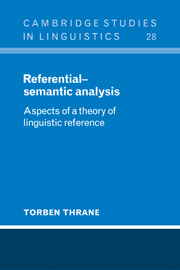Book contents
- Frontmatter
- Contents
- Preface
- Introduction: The functions of language
- PART I THE PRELIMINARIES
- PART II THE THEORY
- 3 SOME FUNDAMENTAL NOTIONS
- 4 THE BASIS OF RS-ANALYSIS
- 5 REFERENTIAL–SEMANTIC FEATURES
- 6 SUBJUNCTION AND ADJUNCTION
- PART III THE APPLICATION
- CONCLUSION: SUMMARY AND FURTHER PROSPECTS
- Bibliography
- Index
4 - THE BASIS OF RS-ANALYSIS
Published online by Cambridge University Press: 06 August 2010
- Frontmatter
- Contents
- Preface
- Introduction: The functions of language
- PART I THE PRELIMINARIES
- PART II THE THEORY
- 3 SOME FUNDAMENTAL NOTIONS
- 4 THE BASIS OF RS-ANALYSIS
- 5 REFERENTIAL–SEMANTIC FEATURES
- 6 SUBJUNCTION AND ADJUNCTION
- PART III THE APPLICATION
- CONCLUSION: SUMMARY AND FURTHER PROSPECTS
- Bibliography
- Index
Summary
Form and function
The grammatical category with whose description I shall be concerned in the present work is the N(oun) P(hrase), or – to put it more precisely – I shall be concerned with an analysis of the linguistic material which is dominated by the label NP in a standard Chomskyan phrase-marker. I shall, however, disregard predicative NPs, i.e. NPs functioning as subject or object complements, which means that only NPs functioning as subject, object, indirect object or complement to a preposition will be taken into account.
I shall call every occurrence of a NP a referential expression, and I shall define a referential expression as an expression by the employment of which we may speak about objects, persons, substances, occurrences, emotions, places, etc. The italicized parts of (1) are referential expressions:
(1)(a) Charles felt a piercing pain in his head
(b) Many are of the opinion that the Concorde should never have been built
(c) In the recent Home Internationals Series, Scotland beat England
(d) Harry was a cab-driver
(e) Everything was quiet in the village
(f) Have you sold the green coat that was in that window yesterday?
(g) She could not explain her feelings to anyone for all the gold in the world
(h) There are no unicorns
(i) John's reckless driving caused the accident.
- Type
- Chapter
- Information
- Referential-Semantic AnalysisAspects of a Theory of Linguistic Reference, pp. 39 - 73Publisher: Cambridge University PressPrint publication year: 1980



